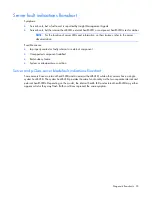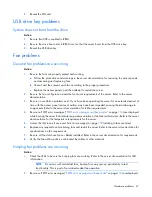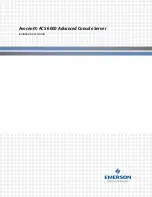
Hardware problems 42
2.
If the device is the only device on a bus, be sure the bus works by installing a different device on the bus.
3.
Restarting the server each time to determine if the device is working, move the device:
a.
To a different slot on the same bus (not applicable for PCI Express)
b.
To a PCI, PCI-X, or PCI Express slot on a different bus
c.
To the same slot in another working server of the same or similar design
If the board works in any of these slots, either the original slot is bad or the board was not properly
seated. Reinsert the board into the original slot to verify.
4.
If you are testing a board (or a device that connects to a board):
a.
Test the board with all other boards removed.
b.
Test the server with only that board removed.
CAUTION:
Clearing NVRAM deletes the configuration information. Refer to the server
documentation for complete instructions before performing this operation or data loss could
occur.
5.
Clearing NVRAM can resolve various problems. Clear the NVRAM, but do not use the backup .SCI file
if prompted. Have available any .CFG, .OVL, or .PCF files that are required.
Internal system problems
Battery pack problems
The battery stops charging or begins to swell
The batteries in BBWC battery packs are a consumable material. After 3 years of service, batteries may not
provide predictable data retention times. If a battery fails completely, the HP Smart Array controller detects
this condition and automatically restricts write cache functions to protect user data. To help ensure
uninterrupted performance levels, HP recommends replacing battery packs at 3-year intervals.
In NiMH batteries, the charging and discharging processes create and recombine inert gases, which can
cause the button cell to swell in size by as much as 20%. Battery packs are designed to stop charging before
excess swelling occurs.
However, if excess swelling does occur, a pressure mechanism within the button cell releases these non-toxic,
non-corrosive gases before the cell incurs physical damage. If this pressure release occurs, the battery no
longer charges properly, and the storage solution reports a failed battery.
CD-ROM and DVD drive problems
System does not boot from the drive
Action
:
1.
Be sure the drive boot order in RBSU is set so that the server boots from the CD-ROM drive first.
2.
If the CD-ROM drive jumpers are set to CS (the factory default), be sure the CD-ROM drive is installed
as device 0 on the cable so that it is in position for the server to boot from the drive.
3.
Be sure no loose connections (on page
19
) exist.
4.
Be sure the media from which you are attempting to boot is not damaged and is a bootable CD.
















































